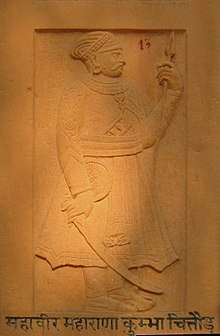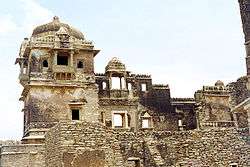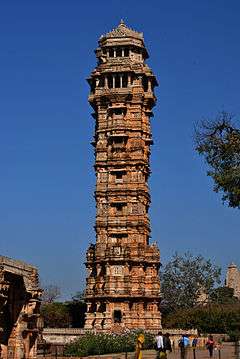Kumbha of Mewar
Kumbhakarna (r. 1433-1468 CE), popularly known as Rana Kumbha, was the ruler of Mewar kingdom of western India. He belonged to the Sisodia clan of Rajputs.[1] Kumbha was a son of Rana Mokal Singh of Mewar by his wife, Sobhagya Devi, a daughter of Jaitmal Sankhla, the Paramara fief-holder of Runkot in the state of Marwar.
| Rana Kumbha | |
|---|---|
 Rana Kumbha | |
| Rana of Mewar | |
| Reign | 1433–68 |
| Predecessor | Mokal Singh |
| Successor | Udai Singh I |
| Died | 1468 |
| Issue | Udai Singh I Rana Raimal |
| Father | Mokal Singh |
| Mother | Sobhagya Devi |
| Sisodia Rajputs of Mewar II (1326–1884) | |
|---|---|
| Hammir Singh | (1326–1364) |
| Kshetra Singh | (1364–1382) |
| Lakha Singh | (1382–1421) |
| Mokal Singh | (1421–1433) |
| Rana Kumbha | (1433–1468) |
| Udai Singh I | (1468–1473) |
| Rana Raimal | (1473–1508) |
| Rana Sanga | (1508–1527) |
| Ratan Singh II | (1528–1531) |
| Vikramaditya Singh | (1531–1536) |
| Vanvir Singh | (1536–1540) |
| Udai Singh II | (1540–1572) |
| Pratap Singh I | (1572–1597) |
| Amar Singh I | (1597–1620) |
| Karan Singh II | (1620–1628) |
| Jagat Singh I | (1628–1652) |
| Raj Singh I | (1652–1680) |
| Jai Singh | (1680–1698) |
| Amar Singh II | (1698–1710) |
| Sangram Singh II | (1710–1734) |
| Jagat Singh II | (1734–1751) |
| Pratap Singh II | (1751–1754) |
| Raj Singh II | (1754–1762) |
| Ari Singh II | (1762–1772) |
| Hamir Singh II | (1772–1778) |
| Bhim Singh | (1778–1828) |
| Jawan Singh | (1828–1838) |
| Sardar Singh | (1828–1842) |
| Swarup Singh | (1842–1861) |
| Shambhu Singh | (1861–1874) |
| Sajjan Singh | (1874–1884) |
| Fateh Singh | (1884–1930) |
| Bhupal Singh | (1930—1955) |
Early period

After being overrun by the armies of Alauddin Khalji at the turn of the 13th century, Mewar had become relatively insignificant. Rana Hammira is credited with casting off the Turkic yoke and establishing the second Guhila dynasty of Chittor in 1335. The title Rana, and later Maharana, was used by rulers of this dynasty.
Rana Hammira's grandson, Maharana Mokal was assassinated by two brothers (Chacha and Mera) in 1433. Lack of support, however, caused Chacha and Mera to flee and Rana Kumbha ascended the throne of Mewar. Initially, Rana Kumbha was ably assisted by Ranmal (Ranamalla) Rathore of Mandore, however Rana Kumbha had Ranmal assassinated because of his growing power, leading to an enmity between the Sisodia and Rathore clans, which would last for decades. In November 1442, Mahmud Khalji, Sultan of Malwa, commenced a series of attacks on Mewar. In 1442 the Sultan destroyed the Bana mata temple and started for Chittor, however he was intercepted by the Rana and a battle was fought at Mandalgarh. The first day was a stalemate, however the next day the Rana made another attack in which the Sultan was defeated and forced to retreat. The Sultan prepared another army and on 1446 he invaded Mewar again, Rana Kumbha attacked the Sultan's army while they were crossing the Banas river and once again defeated the Malwa army. The next series of invasions led by Sultan Mahmud Khilji was on 1456 when he tried to invade Mandalgarh, however he was again defeated by the Rana. The Malwa Sultan then waited for the Rana to move north to fight the Gujarat army and swiftly captured Mandalgarh, Gagraun and adjoining forts but the capture of Chittor and Kumbalgarh eluded him.[2]
Capture of Nagaur and reaction of the sultans
The ruler of Nagaur, Firuz (Firoz) Khan died around 1453-1454. This set into motion a series of events which tested Kumbha's mettle as a warrior. Shams Khan (the son of Firuz Khan) initially sought the help of Rana Kumbha against his uncle Mujahid Khan, who had occupied the throne. After becoming the ruler, Shams Khan, refused to weaken his defenses, and sought the help of Ahmad Shah II, the Sultan of Gujarat (Ahmad Shah died in 1442). Angered by this, Kumbha captured Nagaur in 1456, and also Kasili, Khandela and Sakambhari.
In reaction to this, Ahmad Shah II captured Sirohi and attacked Kumbhalmer. Mahmud Khalji and Ahmad Shah II then reached an agreement (treaty of Champaner) to attack Mewar and divide the spoils. Ahmad Shah II captured Abu, but was unable to capture Kumbhalmer, and his advance towards Chittor was also blocked. Rana Kumbha allowed the army to approach Nagaur, when he came out, and after a severe engagement, inflicted a crushing defeat on the Gujarat army, annihilating it. Only remnants of it reached Ahmedabad, to carry the news of the disaster to the Sultan.
Mahmud Khalji captured Ajmer and in December 1456, conquered Mandalgarh. Taking advantage of Kumbha's preoccupation, Rao Jodha (the son of Ranmal Rathore) captured Mandore. It is a tribute to Rana Kumbha's skills that he was able to defend his kingdom against this multi-directional attack. The death of Qutb-ud-din Ahmad Shah II in 1458, and hostilities between Mahmud Begada (the new ruler of Gujarat) and Mahmud Khalji allowed Rana Kumbha to recapture his lost territories.
Rana Kumbha successfully defended Mewar and expanded his territory at a time when he was surrounded by enemies like Mahmud Khalji of Malwa, Qutbuddin Ahmad Shah II of Gujarat Sultanate, Shams Khan of Nagaur and Rao Jodha of Marwar.
Construction of forts

Kumbha is credited with having worked assiduously to build up the state again. Of 84 fortresses that form the defense of Mewar, 32 were erected by Kumbha.[1] The chief citadel of Mewar, is the fort of Kumbhalgarh, built by Kumbha. It is the highest fort in Rajasthan (MRL 1075m).
Other architecture

Rana Kumbha commissioned the construction of a 37 metre high, nine-storey tower at Chittor. The tower, called Vijay Stambha (Tower of Victory), was completed probably between 1458-68, although some sources date it to 1448.[3][4] The tower is covered with sculptures of Hindu gods and goddesses and depicts episodes from the Ramayana and the Mahabharata.
There are many inscriptions on the Stambha from the time of Kumbha.
- Verse 17: Kumbha is like the mountain Sumeru for the churning of the sea of Malwa. He humbled its king Muhammad.
- Verse 20: He also destroyed other lowly Mleccha rulers (of the neighborhood). He uprooted Nagaur.
- Verse 21: He rescued twelve lakh cows from the Muslim possession and converted Nagaur into a safe pasture for them. He brought Nagaur under the control of the Brahmanas and secured cows and Brahmanas in this land.
- Verse 22: Nagaur was centre of the Mleccha. Kumbha uprooted this tree of evil. Its branches and leaves were automatically destroyed.
The Ranakpur Trailokya-dipaka Jain temple with its adornments, the Kumbhasvami and Adivarsha temples of Chittor and the Shantinatha Jain temple are some of the many other structures built during Rana Kumbha's rule.
Death and aftermath
James Tod, a British administrator in Rajputana who is still much lauded by Rajputs but generally considered unreliable by modern historians, mistakenly believed Rana Kumbha to have married Mira Bai.[5] He was killed in 1468 by his son Udaysimha (Udai Singh I), who thereafter became known as Hatyara (Murderer). Udai himself died in 1473, with the cause of death sometimes being stated as a result of being struck by lightning but more likely to have also been murder.[3]
The lightning strike claim allegedly occurred when Udai was in Delhi, whence he had gone to offer his daughter in marriage to the Delhi Sultan in return for his support for regaining Mewar which was captured by his brother Raimal. In five years of his reign, he lost much of Mewar territory and made Abu Deora Chief independent and gave Ajmer, Sakambhari to Marwar's Rathore king Jodha as a token of friendship (they were cousins). Udai Singh was succeeded not by his son but another brother, Raimal of Mewar. Raimal sought the help of Sultan of Delhi and a battle ensued at Ghasa in which Sahasmall and Surajmall, the rebel brothers were defeated by Prithviraj, second son of Raimal.
However, Prithviraj could not ascend the throne immediately because Raimal was still alive. Nevertheless, he was chosen as the crown prince, as his younger brother Jaimal was killed earlier, and his elder brother Sangram Singh was absconding since the fight between the three brothers.
Prithviraj was ultimately poisoned and killed by his brother-in-law, whom Prithviraj had beaten up for maltreating his sister. Raimal died of grief a few days later, thus paving way for Sangram Singh to occupy the throne. Sangram Singh, who had, meanwhile, returned from self-exile, ascended the throne of Mewar and became famous as Rana Sanga.
See also
References
- Sen, Sailendra (2013). A Textbook of Medieval Indian History. Primus Books. pp. 116–117. ISBN 978-9-38060-734-4.
- Rajasthan through the ages vol 5, pg 5-30
- Ring, Trudy; Watson, Noelle; Schellinger, Paul, eds. (2012). Asia and Oceania: International Dictionary of Historic Places. Routledge. p. 193. ISBN 978-1-13663-979-1.
- "Chittaurgarh Fort, Dist. Chittaurgarh". Archaeological Survey of India. Archived from the original on 21 October 2007.
- Nilsson, Usha (1997). Mira Bai. Sahitya Akademi. ISBN 978-81-260-0411-9.
Further reading
| Wikimedia Commons has media related to Kumbha of Mewar. |
- Lectures on Rajput history and culture by Dr. Dasharatha Sharma. Publisher: Motilal Banarsidass, Jawahar Nagar, Delhi 1970. ISBN 0-8426-0262-3.
Kumbha of Mewar Born: 1433 Died: 1468 | ||
| Preceded by Rana Mokal |
Sisodia Rajput Ruler 1433–1468 |
Succeeded by Udai Singh I |